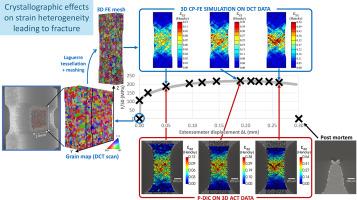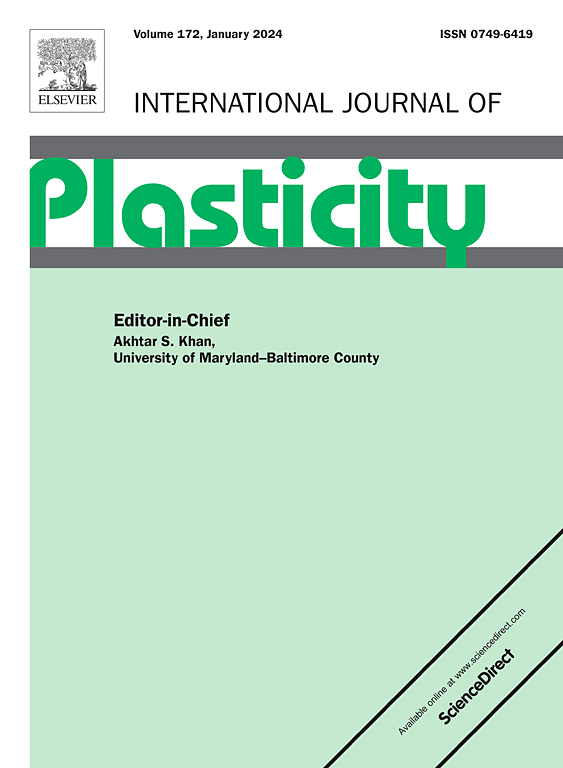3D strain heterogeneity and fracture studied by X-ray tomography and crystal plasticity in an aluminium alloy
IF 9.4
1区 材料科学
Q1 ENGINEERING, MECHANICAL
引用次数: 0
Abstract
Strong correlations between measured strain fields and 3D crystal plasticity finite element (CP-FE) predictions based on the real microstructure are found for a plane strain tensile specimen made of 6016 T4 aluminium alloy. This is achieved using multimodal X-ray lab tomography giving access to both the initial grain structure and the strain evolution. The real microstructure of the central region of interest (ROI) of the undeformed specimen is obtained non destructively using lab-based diffraction contrast tomography (DCT) and meshing. An in situ tensile test, using absorption contrast tomography (ACT) is then performed for twelve loading increments up to fracture. Taking advantage of the plane strain condition, the evolution of the internal strain field is measured by two-dimensional digital image correlation (DIC) in the material bulk using the natural speckle provided by intermetallic particles. Early strain heterogeneities in the form of slanted bands, that are spatially stable over time, are revealed and the fracture path – determined from the post mortem scan – is found to coincide with the bands exhibiting maximum strain. CP-FE simulations are performed on the meshed microstructure of the specimen acquired by DCT and are compared with image correlation measurements. The measured strain fields are well described by 3D CP-FE predictions, whilst it is shown that neither a macroscopic anisotropic plasticity model nor a CP-FE simulation with random grain orientations could reproduce the measurements.


通过 X 射线断层扫描和晶体塑性研究铝合金中的三维应变异质性和断裂情况
在 6016 T4 铝合金平面应变拉伸试样中,发现测量应变场与基于真实微观结构的晶体塑性有限元(CP-FE)预测之间存在很强的相关性。这是通过多模态 X 射线实验室层析技术实现的,该技术可获得初始晶粒结构和应变演变。利用基于实验室的衍射对比断层扫描(DCT)和网格划分技术,非破坏性地获得了未变形试样中心感兴趣区(ROI)的真实微观结构。然后,利用吸收对比层析成像技术(ACT)进行原位拉伸测试,加载 12 个增量,直至断裂。利用平面应变条件,通过二维数字图像相关技术(DIC),利用金属间颗粒提供的自然斑点,测量材料体内部应变场的演变。结果表明,早期的应变异质性以倾斜带的形式存在,且随着时间的推移在空间上保持稳定,根据死后扫描确定的断裂路径与表现出最大应变的应变带相吻合。通过 DCT 获取的试样网格微观结构进行了 CP-FE 模拟,并与图像相关测量结果进行了比较。三维 CP-FE 预测结果很好地描述了测得的应变场,同时表明宏观各向异性塑性模型和具有随机晶粒取向的 CP-FE 模拟都无法再现测量结果。
本文章由计算机程序翻译,如有差异,请以英文原文为准。
求助全文
约1分钟内获得全文
求助全文
来源期刊

International Journal of Plasticity
工程技术-材料科学:综合
CiteScore
15.30
自引率
26.50%
发文量
256
审稿时长
46 days
期刊介绍:
International Journal of Plasticity aims to present original research encompassing all facets of plastic deformation, damage, and fracture behavior in both isotropic and anisotropic solids. This includes exploring the thermodynamics of plasticity and fracture, continuum theory, and macroscopic as well as microscopic phenomena.
Topics of interest span the plastic behavior of single crystals and polycrystalline metals, ceramics, rocks, soils, composites, nanocrystalline and microelectronics materials, shape memory alloys, ferroelectric ceramics, thin films, and polymers. Additionally, the journal covers plasticity aspects of failure and fracture mechanics. Contributions involving significant experimental, numerical, or theoretical advancements that enhance the understanding of the plastic behavior of solids are particularly valued. Papers addressing the modeling of finite nonlinear elastic deformation, bearing similarities to the modeling of plastic deformation, are also welcomed.
 求助内容:
求助内容: 应助结果提醒方式:
应助结果提醒方式:


